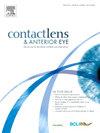Efficacy and utility of clinical examination in predicting meibomian gland atrophy
IF 3.7
3区 医学
Q1 OPHTHALMOLOGY
引用次数: 0
Abstract
Purpose
To investigate the role of clinical examination findings in predicting meibomian gland atrophy (MGA).
Methods
A single-center, cross-sectional study was conducted. Subjective reports of dry eye symptoms were collected via a SPEED questionnaire. Lipid layer thickness, Schirmer I score, lid margin characteristics (thickening, vascular engorgement, and telangiectasia), and meibomian gland secretion factors (quality, expressibility, and volume) were examined and used to generate Foulks-Bron scores. Infrared meibography determined the degree of MGA. Multivariate binary logistic regression analysis determined predictive factors.
Results
When all clinical characteristics were included, the pseudo R2 of the regression model was 0.466 (p-value = 0.029). FB score alone was significantly correlated with MGA severity (R = 0.372, p = 0.014) and had an odds ratio of 1.190 (p = 0.012). Expressibility was the main predictor for severity of MGA with an odds ratio of 2.604 (p = 0.020), sensitivity of 85.7 %, and specificity of 59.1 %. Lipid layer thickness (p = 0.042) and vascular engorgement (p = 0.032) were also predictive of MGA.
Conclusion
A thorough physical examination emphasizing manual expression of meibomian glands can be useful for predicting gland atrophy. Nevertheless, most of the variability in MGA cannot be explained by clinical characteristics, and the full spectrum of contributing factors remains incompletely understood.
临床检查预测睑板腺萎缩的疗效及应用。
目的:探讨临床检查结果在预测睑板腺萎缩(MGA)中的作用。方法:采用单中心横断面研究。通过SPEED问卷收集干眼症状的主观报告。检查脂质层厚度、Schirmer I评分、眼睑边缘特征(增厚、血管充盈和毛细血管扩张)和睑板腺分泌因子(质量、表达性和体积),并用于生成Foulks-Bron评分。红外标记法测定了MGA的程度。多元二元logistic回归分析确定预测因素。结果:纳入所有临床特征后,回归模型的拟R2为0.466 (p值= 0.029)。单独FB评分与MGA严重程度显著相关(R = 0.372, p = 0.014),优势比为1.190 (p = 0.012)。表达性是MGA严重程度的主要预测因子,比值比为2.604 (p = 0.020),敏感性为85.7%,特异性为59.1%。脂质层厚度(p = 0.042)和血管扩张(p = 0.032)也是MGA的预测指标。结论:全面的体格检查强调睑板腺的手工表达,可用于预测睑板腺萎缩。然而,MGA的大多数变异性不能用临床特征来解释,而且所有的影响因素仍然不完全清楚。
本文章由计算机程序翻译,如有差异,请以英文原文为准。
求助全文
约1分钟内获得全文
求助全文
来源期刊

Contact Lens & Anterior Eye
OPHTHALMOLOGY-
CiteScore
7.60
自引率
18.80%
发文量
198
审稿时长
55 days
期刊介绍:
Contact Lens & Anterior Eye is a research-based journal covering all aspects of contact lens theory and practice, including original articles on invention and innovations, as well as the regular features of: Case Reports; Literary Reviews; Editorials; Instrumentation and Techniques and Dates of Professional Meetings.
 求助内容:
求助内容: 应助结果提醒方式:
应助结果提醒方式:


